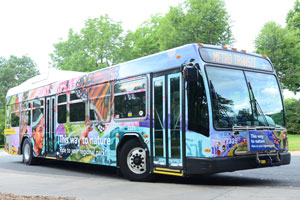Access to Destinations
Connecting to regional destinations and beyond
Objectives
- Increase the availability of multimodal travel options, especially in congested highway corridors.
- Increase reliability and predictability for travel on highway and transit systems.
- Ensure access to freight terminals such as river ports, airports, and intermodal rail yards.
- Increase the number and share of trips taken using transit, carpools, bicycling, and walking.
- Improve the availability and quality of multimodal travel options for people of all ages and abilities to connect to jobs and other opportunities, particularly for historically underrepresented populations
Strategies summarized
- The region will focus on providing a transportation system that offers practical and affordable options, so all users, regardless of their social or economic background, can get to the places they need to go.
- This plan emphasizes the importance of improving and expanding transportation options through investments in a multimodal system with regional bicycle access and local pedestrian amenities; transitways, local and express bus services; and highways with E-ZPass options.
- The plan emphasizes connecting people to destinations, like grocery stores, work, parks, and childcare, and investments that lead to prosperity for all people.
Providing access is transportation’s fundamental purpose. There are ways access can be better provided, and there are barriers to good access that need to be managed or eliminated.
Both population and employment are forecasted to increase in the coming years. Maintaining good regional access to destinations requires putting in place a variety of strategies and tools to address congestion, including offering multimodal options, implementing travel demand and congestion management, and making highway improvements.

Travel demand management
This encompasses strategies like promoting transit, biking, and walking, as well as encouraging employers to increase teleworking and flexible work hours. Congestion management uses technology to help manage the flow of traffic during rush hours and to clear incidents quickly.
Highway improvements
Investments focus on low-cost, high-benefit spot mobility upgrades, E-ZPass Minnesota lanes, and strategic capacity enhancements as a final option. E-ZPass lanes are free for cars with two or more passengers, or single occupant vehicles and small delivery truck fee subscribers. These lanes provide a less congested, more reliable route for transit and carpools during peak use times.
Transit advantage
In heavily traveled corridors, all regional transit can have an advantage with bus-only highway shoulders, ramp meter bypasses, and park-and-ride lots. Bikeway and walkway improvements aim at increasing access, connectivity, and safety.
Access to frequent and convenient transit has not historically been available for all riders. People of color and American Indians, people who have low incomes or who have a disability, or those who don’t have access to a car need transit options to increase access and opportunities for employment, education, and training.
Freight
Efficient freight transport through and within the region is vital to our economic competitiveness. Maintaining existing freight-related infrastructure like ports and intermodal rail yards is a cost-effective strategy, maintaining access to critical regional connections.
Measuring performance
Performance measures used to measure improved mobility and access to destinations include:
- Access to jobs
- E-ZPass usage
- Percentage of travel by modes other than single-occupant vehicles
- Transit ridership
- Mode participation rate
- Peak hour excessive delay
- Average aircraft delay at MSP International Airport
- Regional bicycle transportation network implementation